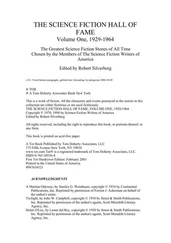A few days later the Pontifical party set out on the return journey to the Labyrinth: by ship along the north shore of the Stoienzar Peninsula to Treymone of the famous tree-houses, and overland from there through the Velalisier Valley and the Desert of the Labyrinth to the imperial capital. Dekkeret stood with Prestimion at the royal quay on the Stoien waterfront for a brief farewell as Varaile and the Pontifex’s children boarded their vessel. Septach Melayn and Gialaurys remained tactfully to one side. At Dekkeret’s request, they would be accompanying him into Zimroel on the grand processional.
Dekkeret spoke briefly of his regrets over the harsh words that had passed between them not long before; but Prestimion brushed that aside, saying that he regretted his own anger at that breakfast meeting at least as much, and that the whole episode was best put out of mind. Out of it, he pointed out, had come a general agreement between them on some of the greatest matters of state that any Coronal and Pontifex had ever had to contemplate.
Prestimion did not need to add that the specific set of tactics to use in handling the Zimroel problem was something he was leaving in Dekkeret’s hands. They both knew that: this was a Coronal’s task, not a Pontifex’s.
As for the advent of the fourth Power of the Realm and Dinitak’s designation as King of Dreams, they left any recapitulation of that unsaid also. Dekkeret knew that Prestimion was still uncomfortable with the concept, but that he would not stand in the way of implementing it—eventually. Prestimion had had his conference with Dinitak, although neither man chose to discuss with Dekkeret what had taken place. Evidently all had gone well, Dekkeret concluded. The campaign against Mandralisca came first, though.
At the end they embraced, and it was a warm one, though it was, as always, an awkward business on account of the difference in their heights. Prestimion bade Dekkeret farewell, and congratulated him once more on his marriage, and wished him well in his grand processional, and told him they would meet again at the Castle once the work at hand had been consummated. Then he turned and walked in all imperial dignity aboard the vessel that would carry him to Treymone, without looking back.
Dekkeret himself, his bride, his companions Dinitak Barjazid and Septach Melayn and Gialaurys, and the rest of the royal entourage were on their way five days later. They too began their journey by ship, sailing northward from Stoien across the Gulf to the quiet little port of Kimoise on the western coast. Fast floaters were waiting there that took them up the coast to Alaisor via Klai and Kikil and Steenorp, a retracement in reverse of the route they had followed down to Stoien for Dekkeret’s rendezvous with the Pontifex. But there would be a long wait in Alaisor while the fleet was assembled and the troops mobilized.
For it was a mobilization. Dekkeret had no illusions about that. He knew he had to go across to Zimroel prepared to fight a war. But the great test of his reign would lie in whether he could succeed in sidestepping that war. Would that be possible? He profoundly hoped so. He was the Coronal Lord of Zimroel as well as that of Alhanroel, but he did not want to win the loyalty of the citizens of the western continent by the sword.
This was Dekkeret’s fourth visit to Alaisor, the major metropolitan center of the western coast. But he had never had time on the other three journeys to see the great city properly.
On his first visit, traveling to Zimroel with Akbalik of Samivole years ago when he was still just a young knight-initiate, he had stopped there only long enough to catch the ship that would take them across the Inner Sea. He had passed through Alaisor again a couple of years later, this time an even shorter visit, for that was the frenzied time when he was racing across the world to the Isle of Sleep to bring word to Lord Prestimion that Venghenar Barjazid had escaped from prison at the Castle and intended to turn his thought-control helmets over to the rebel Dantirya Sambail. And on this most recent visit, just a few months before, Dekkeret had been there only a couple of days before receiving word that Prestimion had arrived in Stoien and requested his immediate presence. He had barely had an opportunity to place a wreath on the tomb of Lord Stiamot before it was necessary to move onward.
Now, though, there was more than ample time to experience the marvels of Alaisor. Dekkeret would gladly have been on his way to Zimroel without delay. But there were ships to call in from other ports, new ones to construct, soldiers to levy from the surrounding provinces. Like it or not, his stay in Alaisor was going to be an extended one this time.
It was a superbly located city, an ideal seaport. The River Iyann, running westward through upper Alhanroel, reached the sea here. By carving a deep track through the lofty palisade of black granite cliffs that ran parallel to the shore, the river had created a link between the districts of the interior and the great crescent bay at the base of the mountains. That bay at the mouth of the Iyann had become the harbor of Alaisor. The city itself had sprung up primarily along the coastal strip, with tendrils of urban settlement reaching behind it into the hills to form the spectacularly situated suburb of Alaisor Heights.
Dekkeret and Fulkari were housed in the four-level penthouse suite atop the thirty-story Alaisor Mercantile Exchange where visiting royalty usually stayed. From their windows they could see the dark spokes of the grand boulevards that ran toward the waterfront from all corners of the city, converging just below them in the circle marked by six colossal black stone obelisks that was the site of Lord Stiamot’s tomb. Stiamot had been en route to Zimroel in his old age, the story went, to ask the pardon of the Danipiur of the Metamorphs for the war he had waged against her people, when he fell mortally ill in Alaisor. He had asked to be buried facing the sea. Or so the story went.
“I wonder if he’s really buried there,” Dekkeret said, as they looked down on the ancient tomb. Some people of Alaisor were moving among the obelisks, strewing handfuls of bright flowers. The tomb was freshly bedecked with blossoms every day. “For that matter, did he ever exist at all?”
“So you doubt him too, the way you doubted Dvorn, when we were at his tomb.”
“It’s the same thing. I agreed that someone whose name was Dvorn probably was Pontifex at some time or other long ago. But was he the one who founded the Pontificate? Who knows? It was thirteen thousand years ago, and at that distance in time do we have any good way of distinguishing history from myth? Likewise with Lord Stiamot: so ancient that we can’t be sure of a thing.”
“How can you say that? He lived only seven thousand years ago. Seven’s very different from thirteen. Compared with Dvorn, he’s practically our contemporary!”
“Is he? Seven thousand years—thirteen thousand—these are incredible numbers, Fulkari.”
“So there never was a Lord Stiamot at all?”
Dekkeret smiled. “Oh, there was a Lord Stiamot, all right. And either he or somebody else of the same name probably was the one who conquered the Metamorphs and sent them off to live in Piurifayne, I suppose. But is he the man who’s buried under those black obelisks? Or did they just bury someone there, five or six thousand years ago, someone important at that time, and gradually the idea took hold that the person in that tomb is Lord Stiamot?”
“You’re terrible, Dekkeret!”
“Simply realistic. Do you believe that the real Stiamot was anything like the man the poets tell us about? That superhuman hero, striding from one end of the world to the other the way you or I would walk across the street? My guess is that the Lord Stiamot of The Book of Changes is ninety-five percent fable.”
Читать дальше












